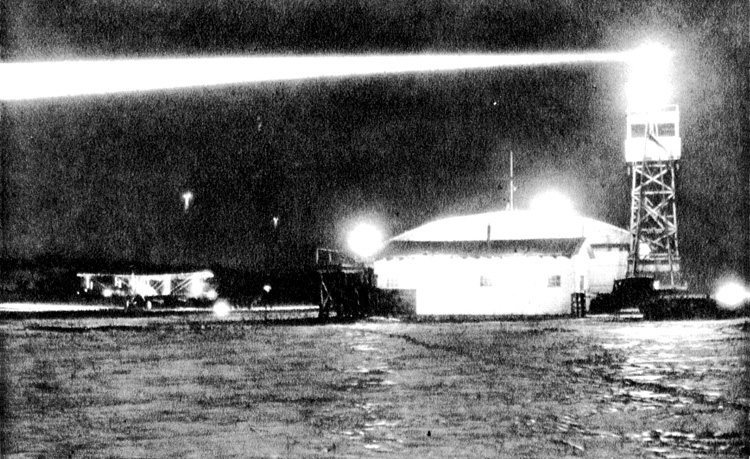
Markers and beacons light the Iowa City airstrip in 1924 as one of 34 original refueling and mail transfer stops on U.S. airmail
flights between New York and San Francisco. The lights replaced bonfires used earlier to mark the landing site after dark.
|
By
Bob Hibbs A
crowd estimated at more than 3,500 greeted the first transcontinental airmail
flight when it landed amid gathering dusk of July 1, 1924 at Smith Field, now
Iowa City Municipal Airport. Among
other mail on its New York to San Francisco route, the plane carried a letter
from the Merchants Association of New York for the Iowa City Chamber of
Commerce. The
event was an exciting spectacle during the Roaring Twenties amid widespread
fascination with flight. It drew spectators for an expected night landing on
the newly-lighted field. However the plane arrived nearly an hour early in
twilight as an eight-million candle power beacon rotated atop a new 50-foot
tower. A
500-million candle power unit was on standby for use during fog and storms. The
event wasn’t the first local airmail flight, nor was it at the first local
airfield. Local
flight took off Oct. 13, 1910 from a 40-acre Johnson County fairgrounds, now
the Morningside Drive neighborhood west of current Iowa City High School. The
demonstration by St. Louis pilot Tom Baldwin was among the first airplane
flights in Iowa. It followed a May flight at Burlington and two at Sioux City
in June, all in 1910. Flying
on a windy day above a crowd of more than 10,000, Baldwin’s plane skipped
off a treetop near the current site of City High’s Statue of Liberty
monument and crashed. He escaped with minor scratches. During
the subsequent decade, local flights remained rare, and shifted to a
quarter-mile square pasture owned by W. J. Benjamin, part of the current
airport site. The farm became established as the local airport with use on
Jan. 8, 1920 as a fuel stop for the first day-time airmail flight from Chicago
to Omaha. Iowa
City became legendary with the Jan. 9 return flight when Iowa City merchant
Robert Carson shipped a 10-pound pig to Chicago friend and hotel manager John
Burke. The publicity stunt prompted widespread reports of Burke walking his
“Airmail Pig” on Chicago’s lakefront. Before
artificial lights arrived locally in 1924 and decades before flight radios,
pilots arriving at night would buzz the city and airfield, in effect
requesting bonfires to mark the field. The
late Claude Higginbotham, known to his long-time barber trade as Hicks and an
uncle to this reporter’s wife, recalled racing to the airport as part of a
team to assist night-arriving and weather-affected planes. Kerosene and wood
supplies made quick infernos as beacons. The
pioneer 1920 airmail flight through Iowa City was piloted by Walter J. Smith,
who’s death in an airplane crash two years after the historic flight
prompted naming the Iowa City field for him. Voters
approved 1929 bonds to buy and improve Smith Field as a municipal airport. It
now has 70 aircraft based there, and encompasses 450 acres, including 54 acres
under commercial development. As
World War II approached the airport became a regional center for pilot
training. From 1939 through 1944 more than 2,500 took Civilian Pilot Training
as part of a Civil Aeronautics Authority program to provide pilots for the war
effort. The school was headed by local pilot Paul Shaw. Shaw
had flown his only airplane – an Air King – from Cedar Rapids to Iowa City
in 1928 and began giving lessons. His effort was separate from Naval
Pre-Flight School which gave initial 90-day training to some 25,000 on the
University of Iowa campus during WWII. A few in pre-flight took Shaw’s
training, too. At
peak during 1944, Shaw employed 22 instructors using 32 single-engine
aircraft. Commercial
airlines served Iowa City from 1927 through 1972; first United, then Ozark
Airlines after 1959. With
the centennial of local flight still six years hence, some historic sorties
already have been flown. Next
Saturday: The Mechanics Academy
incubator. Bob Hibbs collects local postcards and other historic ephemera and researches history related to them.
|